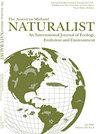Impacts of Herbivory on Photosynthesis of Four Common Wisconsin Plant Species
IF 0.6
4区 环境科学与生态学
Q4 Agricultural and Biological Sciences
引用次数: 2
Abstract
Abstract. Overcompensation to herbivory is prevalent among plant species. However, we do not yet fully understand why plant species vary in their compensatory abilities. It is highly likely that overcompensation is determined by the ability of plants to elevate photosynthesis in response to herbivory, which is dictated by evolutionary exposure to grazing. Here, we tested the hypothesis that photosynthetic overcompensation should be predictable based on plant life form by simulating herbivore damage on four plant species: two common range grasses with long evolutionary exposure to grazing (Andropogon gerardii, Bouteloua curtipendula) and two common understory forbs that are resistant to, and therefore experience little, grazing (Alliaria petiolata, Symplocarpus foetidus). We measured leaf-level gas exchange in a high-resolution time series that extended throughout the growing season. We found no evidence of photosynthetic compensation for three of the four plant species. Interestingly, only A. petiolata, a highly invasive species, demonstrated increased photosynthesis and stomatal conductance following clipping. Further, the effects were short-lived, as both photosynthesis and stomatal conductance returned to baseline levels within 24 h. Our results suggest that elevated photosynthesis to herbivory might not be a general mechanism by which plants either resist or tolerate herbivory.草食对威斯康星州四种常见植物光合作用的影响
摘要对草食性的过度补偿在植物物种中很普遍。然而,我们还没有完全理解为什么植物物种的补偿能力各不相同。过度补偿很可能是由植物提高光合作用以应对草食性的能力决定的,而草食性是由放牧的进化暴露决定的。在这里,我们通过模拟四种植物物种的食草动物损伤,验证了光合过度补偿应该是基于植物生命形式可预测的假设:两种长期进化暴露于放牧的常见草地草(Andropogon gerardii,Bouteloua curtipendula)和两种常见的林下杂草,放牧(小葱属,风铃草属)。我们在一个高分辨率的时间序列中测量了叶片水平的气体交换,该时间序列贯穿整个生长季节。我们没有发现四种植物中有三种有光合补偿的证据。有趣的是,只有海鞘A.petiolata,一种高度入侵的物种,在修剪后表现出光合作用和气孔导度的增加。此外,这种影响是短暂的,因为光合作用和气孔导度在24小时内都恢复到了基线水平。我们的结果表明,对食草动物光合作用的提高可能不是植物抵抗或耐受食草动物的一般机制。
本文章由计算机程序翻译,如有差异,请以英文原文为准。
求助全文
约1分钟内获得全文
求助全文
来源期刊

American Midland Naturalist
环境科学-生态学
CiteScore
1.20
自引率
0.00%
发文量
38
审稿时长
18-36 weeks
期刊介绍:
The American Midland Naturalist has been published for 90 years by the University of Notre Dame. The connotations of Midland and Naturalist have broadened and its geographic coverage now includes North America with occasional articles from other continents. The old image of naturalist has changed and the journal publishes what Charles Elton aptly termed "scientific natural history" including field and experimental biology. Its significance and breadth of coverage are evident in that the American Midland Naturalist is among the most frequently cited journals in publications on ecology, mammalogy, herpetology, ornithology, ichthyology, parasitology, aquatic and invertebrate biology and other biological disciplines.
 求助内容:
求助内容: 应助结果提醒方式:
应助结果提醒方式:


